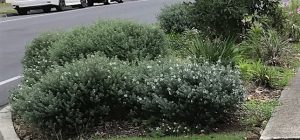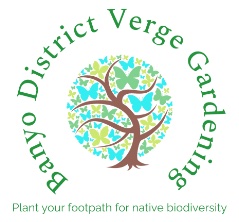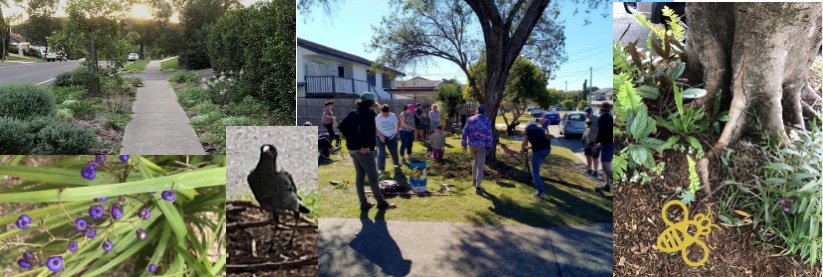The Banyo Verge Garden Pilot Project was funded by a grant from the inGrained Foundation in 2022. The grant was matched with an in-kind contribution by The Shady Lanes Project.
The pilot project ended in September 2023 and the baton was passed to the Banyo community and the Banyo District Community Group Inc.
The pilot project aimed to transform a streetscape in Brisbane into a cooler, greener, walkable neighbourhood with Council-planted street trees and predominantly local native understory, in accordance with the Brisbane City Council Verge Garden Guidelines.
- Plants will be predominantly native plants indigenous to the region grown for habitat and soil health.
- These gardens support street trees that are planted and maintained by Council – roots must not be disturbed and trunks must be clear of mulch or soil buildup.
- This is slow, low-impact gardening for biodiversity – with no herbicides or pesticides.
BENEFICIARIES
Residents
This project will offer residents a community building opportunity, as households will be invited to meet and discuss the planting projects. Green spaces often act as neighbourhood meeting points, connecting communities and bringing people together.
Improved Mental health and wellbeing – walkable streets, active transport, connection to nature, cooler suburbs, increasing incidental interaction in street reduces loneliness. (ref)
Urban vegetation can reduce average maximum peak daily temperatures by up to 1.8°C and night-time temperatures by up to 2.3°C.32 A 0.1ºC reduction in peak daily temperature has been found to lower death rates by an average of 3%.3. (Temperature check: Greening Australia’s warming cities – Australian Conservation Foundation)
Employees of Social Enterprise contract
We will engage with local Social Enterprises that make business decisions which support an inclusive and just community as well as a sustainable environment. Our project will help create job opportunities and new training opportunities for those who have been excluded.
Wildlife
 Green spaces such as verge gardens can form corridors for wildlife, reconnecting habitat and attracting native birds, lizards, and insects.
Green spaces such as verge gardens can form corridors for wildlife, reconnecting habitat and attracting native birds, lizards, and insects.
Native plants will also increase soil biodiversity.
Community Networks
Working together on regenerative projects such as this will strengthen social and environmental infrastructure that, in turn, will make communities more resilient when dealing with the effects of climate change and biodiversity loss.
Households involved in the pilot project will benefit from connecting with their neighbours, beautifying their verge spaces and connecting with others in the community.
Government Services/infrastructure
Leafy urban suburbs can reduce projected daily hospital admission rates for dehydration and heatstroke by 15% and 30%, respectively.
Green infrastructure slows and reduces immediate stormwater loads that infrastructure receives.79,80. It reduces strain on the drainage systems by reducing flow speeds and volume and so reduces the average annual damage to infrastructure.
(Temperature check: Greening Australia’s warming cities – Australian Conservation Foundation)
OUTCOMES
- a more connected, healthy and biodiverse natural landscape within certain areas of the city that was previously identified as deficient.
- strengthened community connection to local place.
- strengthened ecological, social, cultural and economic infrastructure that is more resilient to crisis events.
- resident-maintained nature strips support the health of street trees at no cost to council
- increased tree canopy in cities helps tackle the urban heat island effect, cooling the suburbs and reducing air-conditioning bills
- more diverse habitat for native wildlife and pollinators
- opportunities for city dwellers to engage with nature close to home as part of daily life, giving physical and mental health benefits
- cooler and more pleasant walkways encourage walking and active transport, giving health benefits and reducing emissions
- reduction in green waste and emissions from mowers
- reducing rainwater runoff from urban areas into the stormwater system
- improving the soil health and sequestering some carbon
- Vegetation acts as a carbon sink, converting carbon dioxide to oxygen through the process of photosynthesis. This reduces the amount of carbon dioxide in the atmosphere, helping to mitigate the impacts of climate change.
MEASURABLES
Measurements include:
-
- Number of trees and plant species on completion and one year after.
- Survey of residents before and after. Qualitative surveys will be used to measure what participating residents think, learn and share about the project, before and after (social impact)
- Stories about the project published on Shady Lanes website and social media
- Individual Verge Garden stories on the Shady Lanes website in the Banyo/Nudgee category
- Increased number of similar and interconnecting projects
- Number of people joining our networks and being active participants in similar projects.

